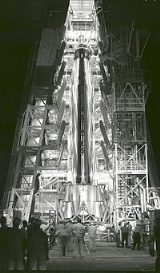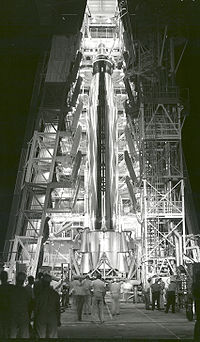
Big Joe 1
Encyclopedia

Mercury program
Mercury Program might refer to:*the first successful American manned spaceflight program, Project Mercury*an American post-rock band, The Mercury Program...
capsule from Cape Canaveral
Cape Canaveral Air Force Station
Cape Canaveral Air Force Station is an installation of the United States Air Force Space Command's 45th Space Wing, headquartered at nearby Patrick Air Force Base. Located on Cape Canaveral in the state of Florida, CCAFS is the primary launch head of America's Eastern Range with four launch pads...
, Florida on September 9, 1959. The objective of the Big Joe program was to test the Mercury
Mercury program
Mercury Program might refer to:*the first successful American manned spaceflight program, Project Mercury*an American post-rock band, The Mercury Program...
spacecraft ablating heat shield
Heat shield
A heat shield is designed to shield a substance from absorbing excessive heat from an outside source by either dissipating, reflecting or simply absorbing the heat...
. It was also the first Project Mercury flight using an Atlas booster.
The flight was both a success and failure—the heat shield survived reentry and was in remarkably good condition when retrieved from the Atlantic Ocean
Atlantic Ocean
The Atlantic Ocean is the second-largest of the world's oceanic divisions. With a total area of about , it covers approximately 20% of the Earth's surface and about 26% of its water surface area...
. The Atlas-D
SM-65D Atlas
The SM-65D Atlas, or Atlas D, was the first operational version of the U.S. Atlas missile. It first flew on April 14, 1959. Atlas D missiles were also used for orbital launches, both with upper stages and on their own as a stage-and-a-half vehicle....
booster, however, failed to stage and separated too late from the Mercury capsule. Due to the added weight of the unseparated booster engines, the sustainer engine depleted its fuel supply 14 seconds early. The boilerplate capsule was not equipped with a launch escape system.
The Mercury
Mercury program
Mercury Program might refer to:*the first successful American manned spaceflight program, Project Mercury*an American post-rock band, The Mercury Program...
capsule flew a 1,424 mile (2,292 km) ballistic flight to the altitude of 90 miles (144.8 km). The capsule was recovered and studied for the effect of re-entry heat and other flight stresses from its 13-minute flight. Since the data from Big Joe 1 satisfied NASA requirements, a second launch, Big Joe 2 (Atlas 20D), which had been scheduled for the fall of 1959, was canceled and the launch vehicle was transferred to another program.
Capsule weight: 2,555 lb (1,159 kg). Serial numbers: Atlas 628/10-D, Mercury spacecraft - prototype.
The Mercury spacecraft used in the Big Joe 1 mission is displayed at the National Air and Space Museum
National Air and Space Museum
The National Air and Space Museum of the Smithsonian Institution holds the largest collection of historic aircraft and spacecraft in the world. It was established in 1976. Located in Washington, D.C., United States, it is a center for research into the history and science of aviation and...
's Steven F. Udvar-Hazy Center
Steven F. Udvar-Hazy Center
The Steven F. Udvar-Hazy Center is the Smithsonian National Air and Space Museum 's annex at Washington Dulles International Airport in the Chantilly area of Fairfax County, Virginia, United States....
in Chantilly, Virginia.

